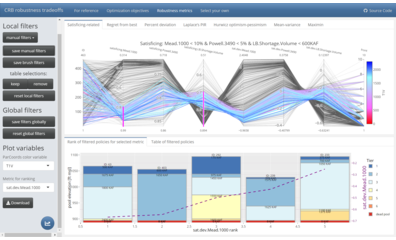Colorado River Basin Robustness Tradeoffs dashboard
Authors: Nathan Bonham
Abstract: This app is a decision support dashboard for the Bureau of Reclamation to identify robust water management policies in the Colorado River Basin. Water managers filter policies by performance objectives, robustness metrics, and decision variables.
Full Description: The Colorado River Basin (CRB) Robustness Tradeoffs application is a decision support tool for water managers to explore the performance, robustness, and decision variables of hundreds of long-term water management policies for Lake Mead. The CRB provides water for agriculture, hydropower, domestic consumption, and copious other uses of nearly 40 million people in the southwest United States. The future sustainability of the CRB is deeply uncertain, as future climate and water demand projections suggest inevitable water supply deficit. To mitigate and manage this deficit, we used a simulation model and a multi-objective evolutionary algorithm to identify 463 candidate long-term water management policies. The policies define decision variables, which are human-controlled decisions describing how Lake Mead, the largest water reservoir in the United States, is operated such that various water supply and water storage objectives are optimized. After identifying these policies, we perform a “stress-test” where each is re-simulated in 500 future scenarios of hydrology, water demand, and initial reservoir storage. We use the stress-test data and statistical functions, called robustness metrics, to identify which water management policies are robust. A robust policy will perform well according to the performance objectives even when tested in challenging future scenarios. The CRB Robustness Analysis app is a decision support dashboard for use by the Bureau of Reclamation and various stakeholders in the CRB to explore performance objectives, robustness metrics, and decision variables of hundreds of policies and select ones they are interested in. The app uses parallel coordinate plots to visualize performance objectives and robustness metrics, on which the user applies brush filters to highlight policies meeting performance preferences while filtering out ones that do not. Moreover, the parallel coordinates plot is linked to a decision variable plot, which depicts the decision variables describing each Lake Mead policy. Together, the linking of the plots empowers water managers to explore both performance and decision variables while expediently identifying policies of interest for further analysis and political debate. New water management policy will be enacted in the CRB in year 2026, and this research is playing a pivotal role in helping the Bureau of Reclamation identify optimal and robust long-term water management strategies. For technical documentation and an example analysis within the app, please see this report hosted in GitHub: CRB-Robustness-App-BOR/www/R19AC00053_2021-03-31_performance-progress-report.pdf at main · nabocrb/CRB-Robustness-App-BOR · GitHub.
Keywords: parallel coordinates, decision making under deep uncertainty, robust decision making, water resources management, Colorado River Basin, science and policy, flexdashboard
Shiny app: https://nabocrb.shinyapps.io/CRB-Robustness-App-Shiny-Contest
Repo: GitHub - nabocrb/CRB-Robustness-App-BOR: Robustness app for Reclamation
RStudio Cloud: Posit Cloud
Thumbnail:

Full image: